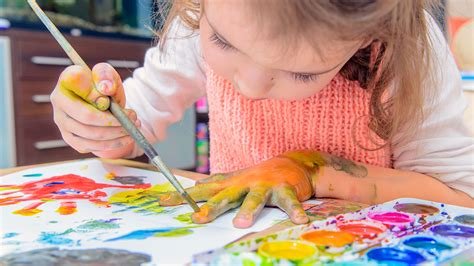Fostering Creativity in Children: Art Activities and Creative Play Ideas
As parents and caregivers, fostering creativity in children is an essential part of their development. In today’s fast-paced and technology-driven world, it’s more important than ever to encourage children to explore their creative side. In this blog post, we will explore the various ways in which we can promote creativity in children through art activities and creative play ideas. From the importance of nurturing creativity in children to the benefits of engaging in art activities, we will delve into the different forms of creative expression and how they can positively impact a child’s development. We will also discuss the role of imaginative play, music, movement, sensory activities, nature, outdoor exploration, collaborative art projects, recycled materials, and role-playing in empowering and inspiring children’s creativity. Join us on this journey as we discover the joy and the benefits of fostering creativity in children.
Importance of fostering creativity in children
Encouraging creative expression in children is essential for their overall development. Creativity helps them think outside the box, solve problems, and express themselves in unique ways. By fostering creativity in children, we are nurturing their ability to adapt, innovate, and explore endless possibilities.
Furthermore, promoting creativity in children can have a positive impact on their mental and emotional well-being. Engaging in art activities allows them to release emotions, reduce stress, and develop a positive sense of self. It also encourages them to communicate their thoughts and feelings effectively, improving their social and communication skills.
In addition, fostering creativity in children helps them develop a lifelong love for learning. When children are encouraged to explore different forms of creative expression, they become more curious, open-minded, and eager to learn. They also develop a sense of confidence and independence as they experiment, make mistakes, and learn from their experiences.
Overall, the importance of fostering creativity in children cannot be overstated. It not only enhances their problem-solving abilities, emotional well-being, and love for learning, but also prepares them to thrive in a rapidly changing and increasingly complex world.
Benefits of art activities for children’s creativity
Art activities for children provide a wide range of benefits for their creativity and development. Engaging in art allows children to express themselves in unique ways, developing their individuality and self-confidence. Through art, children can explore different mediums such as paint, collage, and sculpture, which helps to develop their fine motor skills and hand-eye coordination. These activities also encourage problem-solving and critical thinking skills as children experiment with colors, shapes, and textures to create their own masterpieces.
Additionally, art activities foster a sense of pride and accomplishment in children as they see their work displayed or shared with others. This positive reinforcement helps to boost their self-esteem and motivates them to continue exploring their creativity. Moreover, art can be a therapeutic outlet for children to express their emotions and feelings, providing a healthy and constructive way to cope with challenges and stress. Art also promotes communication and language development as children describe their creations and share their artistic ideas with others.
Furthermore, participating in art activities can inspire a lifelong love for the arts and creative expression. By introducing children to different art forms and styles, they can develop an appreciation for cultural diversity and artistic traditions. This exposure to art from an early age can lead to a deeper understanding and enjoyment of the arts as they grow older. Art activities also encourage children to think outside the box and embrace their imagination, which is essential for fostering innovative and creative thinking in the future.
In conclusion, art activities play a significant role in nurturing children’s creativity and overall development. By offering a wide range of benefits, including improved motor skills, emotional expression, and cognitive development, art activities are an essential component of a well-rounded and enriching childhood.
Exploring different forms of creative expression
When it comes to nurturing creativity in children, it’s important to explore the different forms of creative expression that can help them develop their imaginative skills. Creative expression can come in many different forms, including art, music, movement, storytelling, and sensory activities. By encouraging children to explore these diverse avenues of creativity, we can help them discover their unique talents and interests.
Art activities are a popular way for children to express themselves creatively. Whether it’s painting, drawing, or sculpting, art allows children to engage their senses and emotions while creating something original. By providing them with a variety of art materials and encouraging them to experiment with different techniques, we can help children develop their artistic skills and confidence.
Music and movement are also powerful tools for fostering creativity in children. Through music, children can express their emotions and ideas, while movement allows them to explore space, rhythm, and coordination. By incorporating music and movement into their play and learning activities, we can help children develop a deeper understanding of the world around them and a greater sense of self-expression.
Storytelling is another form of creative expression that can captivate children’s imaginations and inspire them to explore new ideas and perspectives. By encouraging children to engage in imaginative play and create their own stories, we can help them develop their language skills, critical thinking, and creativity.
Encouraging imaginative play through storytelling
Storytelling is a powerful tool for encouraging imaginative play in children. When children are engaged in a story, their imagination comes to life as they visualize the characters, settings, and events in their minds. They begin to create their own narratives and explore different possibilities, sparking their creativity and problem-solving skills.
Through storytelling, children can learn to express themselves and communicate effectively. As they listen to stories and share their own, they develop language skills and vocabulary, ultimately enhancing their ability to express their thoughts and feelings. This form of creative expression not only fosters their imagination but also strengthens their communication abilities.
Storytelling also promotes empathy and emotional intelligence in children. As they connect with the characters in stories, they learn to understand different perspectives and emotions, cultivating their empathy and compassion for others. Through imaginative play based on the stories they hear, children can explore and process complex feelings, enhancing their emotional development.
Overall, storytelling is an invaluable tool for encouraging imaginative play in children. It opens up a world of possibilities, ignites their creativity, and provides a platform for them to express themselves and understand others. By incorporating storytelling into children’s daily routines, parents and educators can nurture their imagination and foster a love for creative expression.
Using music and movement to enhance creativity
Music and movement are powerful tools for enhancing creativity in children. When kids engage in activities such as dancing, singing, or playing instruments, they are not only having fun, but also stimulating their imagination and expression.
Research has shown that exposure to music at a young age can have a positive impact on a child’s cognitive development, including memory, attention, and language skills.
Furthermore, movement activities such as dancing or yoga can help children develop a sense of rhythm and coordination, as well as improve their physical and emotional well-being.
By incorporating music and movement into a child’s daily routine, parents and educators can provide a rich and stimulating environment that fosters creativity and imagination.
Promoting open-ended play with sensory activities
Encouraging children to engage in open-ended play using sensory activities is an essential part of their creative development. By providing them with opportunities to explore various textures, scents, and sounds, they are able to stimulate their senses and foster their imaginations.
Whether it’s through playing with sand, water, or different materials, sensory activities allow children to use their creativity to experiment and discover the world around them in a hands-on way. This not only enhances their fine motor skills but also encourages them to think outside the box and come up with unique ways to interact with their environment.
Furthermore, sensory play can also have a calming and soothing effect on children, helping them to regulate their emotions and develop a sense of mindfulness. By incorporating sensory activities into their daily routines, parents and educators can support children’s emotional well-being while promoting their creativity.
Overall, promoting open-ended play with sensory activities is a wonderful way to inspire children to explore, create, and learn in a fun and meaningful way. It allows them to engage their senses, expand their imagination, and develop important skills that will benefit them throughout their lives.
Integrating nature and outdoor exploration into artistic play
Integrating nature and outdoor exploration into artistic play can have a profound impact on children’s creativity and overall development. By incorporating natural elements such as leaves, flowers, and rocks into art projects, children are able to not only express themselves creatively but also develop a deeper appreciation for the world around them.
Outdoor exploration also provides children with the opportunity to engage all their senses, from the sound of birds chirping to the feel of the wind against their skin. This sensory experience can inspire new ideas and ways of thinking, fostering a more holistic approach to artistic expression.
Furthermore, outdoor play encourages physical activity and a sense of freedom, which can have a positive impact on a child’s mental and emotional well-being. When children are given the space and freedom to explore and create outdoors, they are able to tap into their imagination and develop a stronger sense of self-confidence and independence.
Overall, integrating nature and outdoor exploration into artistic play not only enhances children’s creativity but also allows them to develop a deeper connection to the natural world, fostering a sense of environmental consciousness and stewardship from a young age.
Nurturing creativity with collaborative art projects
Collaborative art projects are a fantastic way to foster creativity in children. When kids work together on a single piece of art, they are encouraged to think outside the box and come up with unique ideas. This collaborative process promotes teamwork and communication skills, as children have to discuss and negotiate their ideas with one another. By working together, they can learn new techniques from each other and broaden their creative perspectives.
Another benefit of collaborative art projects is that they help children develop a sense of community and belonging. Through working together toward a common goal, they feel a sense of pride and accomplishment in the finished work. This can also boost their self-esteem and help them see the value of their unique contributions to the project.
Collaborative art projects also allow children to experiment with different artistic mediums and techniques. They can combine various materials, textures, and colors to create something truly original. This exploratory process can lead to new discoveries and a deeper understanding of artistic expression.
Overall, collaborative art projects are a powerful tool for nurturing creativity in children. By working together, they learn important social skills, gain a sense of community, and have the opportunity to explore different artistic possibilities.
Inspiring creativity through recycled materials and upcycling
When it comes to nurturing creativity in children, one of the most effective ways is through using recycled materials and upcycling. By encouraging kids to repurpose old items and turn them into something new, we not only teach them about sustainability and environmental awareness, but also promote their imaginative and innovative thinking.
Using recycled materials for arts and crafts projects allows children to think outside the box and come up with unique and resourceful ways to create. Whether it’s using old newspaper for papier-mâché, turning plastic containers into planters, or making jewelry out of bottle caps, the possibilities are endless when it comes to upcycling.
Not only does this teach children about the value of reusing and repurposing, but it also helps them develop problem-solving skills and the ability to see potential in objects that others might discard. It also encourages them to think creatively and to experiment with different materials and techniques.
Overall, incorporating recycled materials and upcycling into children’s creative activities not only fosters an appreciation for the environment, but also inspires them to think creatively and find innovative solutions to everyday challenges.
Empowering children’s creativity through role-playing and pretend play
Role-playing and pretend play are powerful tools for fostering imagination and creativity in children. By engaging in these activities, children have the opportunity to step out of their own realities and explore different roles and scenarios, allowing them to exercise their creative thinking and problem-solving skills.
Through role-playing and pretend play, children can try on different personas and experiment with various narratives, expanding their perspective and understanding of the world around them. This encourages them to think outside the box and explore alternative ways of approaching challenges and conflicts.
Furthermore, role-playing and pretend play provide children with a safe space to express themselves and develop their communication and social skills. By engaging in imaginative role-play, children can practice active listening, negotiation, and cooperation, all of which are essential for healthy social and emotional development.
Empowering children’s creativity through role-playing and pretend play also allows them to explore their own identity and build self-confidence. By inhabiting different characters and testing out different scenarios, children can gain a better understanding of themselves and their unique strengths and abilities, ultimately boosting their self-esteem and resilience.
Frequently Asked Questions
Why is fostering creativity in children important?
Fostering creativity in children is important as it helps in developing their critical thinking skills, problem-solving abilities, and emotional intelligence. It also encourages them to express themselves in different ways and boosts their self-confidence.
What are the benefits of art activities for children’s creativity?
Art activities for children can enhance their creativity by allowing them to experiment with colors, textures, and different art mediums. It also helps in improving their fine motor skills, hand-eye coordination, and visual-spatial awareness.
How can parents explore different forms of creative expression with children?
Parents can explore different forms of creative expression with children by introducing them to various art techniques such as painting, drawing, sculpture, and collage-making. They can also encourage children to engage in activities like photography, creative writing, and performing arts.
How can parents encourage imaginative play through storytelling?
Parents can encourage imaginative play through storytelling by reading books, folktales, and fairy tales to children. They can also engage in interactive storytelling sessions and encourage children to create their own stories and imaginary worlds.
How can music and movement enhance creativity in children?
Music and movement can enhance creativity in children by stimulating their senses, improving their coordination, and fostering a sense of rhythm and expression. It also provides them with opportunities for self-expression and emotional release.
What are some ways to promote open-ended play with sensory activities?
Parents can promote open-ended play with sensory activities by providing children with materials like playdough, kinetic sand, water beads, and sensory bins. These activities stimulate the senses and encourage children to explore and create without set limitations.
How can nature and outdoor exploration be integrated into artistic play?
Nature and outdoor exploration can be integrated into artistic play by taking children on nature walks, collecting natural materials like leaves, flowers, and rocks, and using them in art and craft activities. Children can also engage in outdoor painting, drawing, and nature-inspired creative projects.
How can parents nurture creativity with collaborative art projects?
Parents can nurture creativity with collaborative art projects by organizing group art sessions, encouraging teamwork and sharing of ideas, and guiding children to work together on a common artistic vision. Collaborative art projects promote communication, cooperation, and creative problem-solving skills.
How can creativity be inspired through recycled materials and upcycling?
Creativity can be inspired through recycled materials and upcycling by introducing children to the concept of repurposing and transforming everyday items into new and imaginative creations. It encourages environmental awareness, resourcefulness, and innovation.






